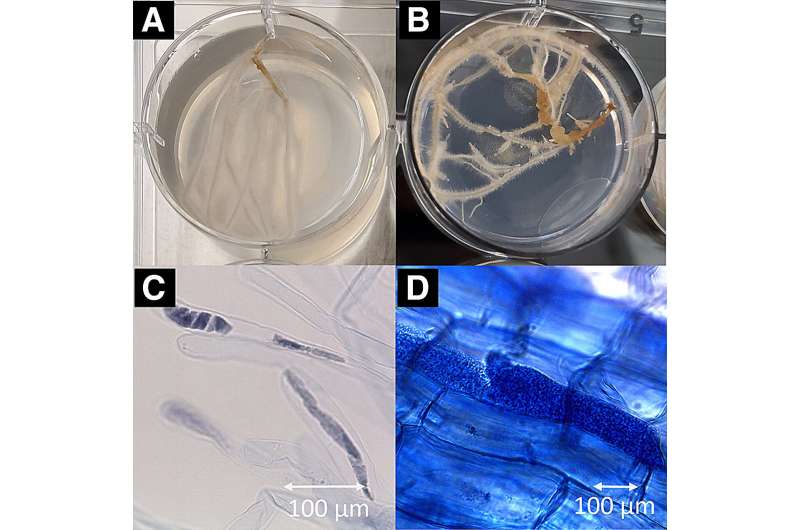Science
Researchers Discover Key Role of Salicylic Acid in Potato Defense

A team of plant scientists has made a significant discovery regarding potato plants’ defense mechanisms against the pathogen Spongospora subterranea f. sp. subterranea (Sss), which causes powdery scab—a disease that poses a serious threat to potato crops worldwide. Their study, published on July 23, 2025, in the journal Molecular Plant-Microbe Interactions, reveals that potato plants depend on salicylic acid (SA), a well-known plant hormone, to protect their roots from this pathogen.
While salicylic acid is recognized for its role in triggering immune responses in plants, it also has historical significance in human medicine as a precursor to aspirin. The study highlights the unique nature of Sss, which is classified as a protist—a single-celled organism that is less commonly associated with plant diseases compared to fungi or bacteria. Due to its inability to be cultured in laboratory settings and its capacity to survive in soil for extended periods, Sss has been particularly challenging to study and control through traditional agricultural methods.
According to Kiwamu Tanaka from Washington State University, “Plants use different immune strategies depending on the type of pathogen attacking them.” The research team suspected that the salicylic acid pathway was involved in the plant’s defense against Sss, given its behavior as a biotroph that feeds on living plant tissue.
To investigate this hypothesis, the researchers analyzed the changes in hormone levels within potato roots following infection by Sss. They discovered a marked increase in salicylic acid levels after infection, while levels of other defense-related hormones, such as jasmonic acid, remained steady. Genetic experiments further confirmed that disrupting the salicylic acid signaling pathway made the plants more susceptible to infection, while enhancing this pathway improved their resistance. This evidence underscores the central role of salicylic acid in the immune response of potatoes to Sss.
Innovative Research Techniques Accelerate Findings
The research team employed a cutting-edge “hairy root” system to facilitate their experiments. This method involves inducing hormone-independent root structures using a bacterium called Rhizobium rhizogenes, allowing researchers to study root-pathogen interactions in a controlled environment. Unlike traditional soil assays, which can take months to yield results, this system enabled consistent infection results in just 2 to 4 weeks, significantly speeding up the research process.
The implications of Sss extend beyond causing powdery scab; it can also transmit the potato mop-top virus (PMTV), which leads to tuber necrosis and is classified as a quarantine pathogen in certain countries. This dual threat emphasizes the need for an integrated management strategy that combines host resistance, insights into pathogen biology, and consideration of environmental factors.
By focusing on Sss, researchers aim to develop control measures that effectively target both significant potato diseases. As Samodya Jayasinghe, the study’s first author, noted, “This is the first time we’ve had a clear picture of how potatoes naturally defend themselves against this kind of pathogen. Because Sss is so hard to study and there are no effective treatments, our findings offer a vital foundation for developing potato varieties with improved resistance—something the global industry urgently needs.”
This groundbreaking research not only advances the understanding of potato plant defenses but also lays the groundwork for future agricultural innovations aimed at combating the threats posed by Sss and PMTV, ensuring the sustainability of potato production worldwide.
-

 Entertainment2 months ago
Entertainment2 months agoIconic 90s TV Show House Hits Market for £1.1 Million
-

 Lifestyle4 months ago
Lifestyle4 months agoMilk Bank Urges Mothers to Donate for Premature Babies’ Health
-

 Sports3 months ago
Sports3 months agoAlessia Russo Signs Long-Term Deal with Arsenal Ahead of WSL Season
-

 Lifestyle4 months ago
Lifestyle4 months agoShoppers Flock to Discounted Neck Pillow on Amazon for Travel Comfort
-

 Politics4 months ago
Politics4 months agoMuseums Body Critiques EHRC Proposals on Gender Facilities
-

 Business4 months ago
Business4 months agoTrump Visits Europe: Business, Politics, or Leisure?
-

 Lifestyle4 months ago
Lifestyle4 months agoJapanese Teen Sorato Shimizu Breaks U18 100m Record in 10 Seconds
-

 Politics4 months ago
Politics4 months agoCouple Shares Inspiring Love Story Defying Height Stereotypes
-

 World4 months ago
World4 months agoAnglian Water Raises Concerns Over Proposed AI Data Centre
-

 Sports4 months ago
Sports4 months agoBournemouth Dominates Everton with 3-0 Victory in Premier League Summer Series
-

 World4 months ago
World4 months agoWreckage of Missing Russian Passenger Plane Discovered in Flames
-

 Lifestyle4 months ago
Lifestyle4 months agoShoppers Rave About Roman’s £42 Midi Dress, Calling It ‘Elegant’









